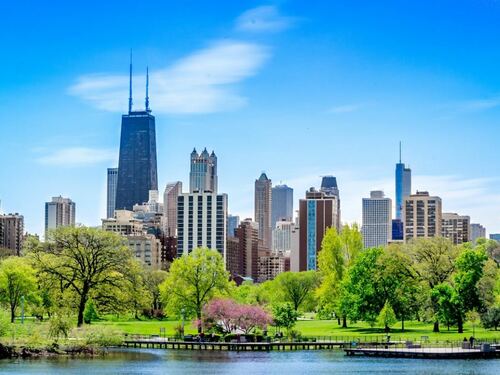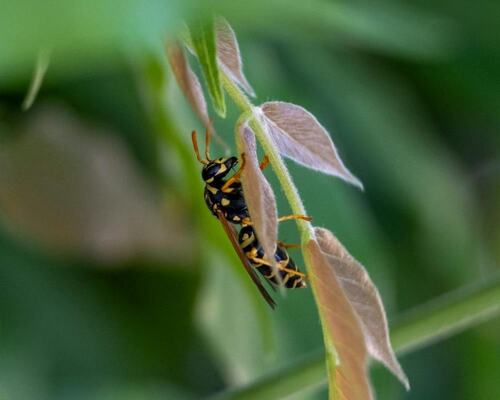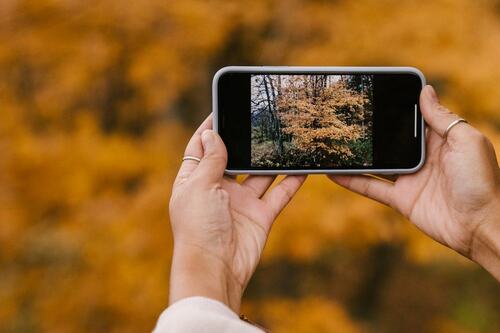Urban Trees: Lifelines for Pollinators in 2024
Introduction
Did you know that a single mature tree can produce up to 260 pounds of oxygen per year? That’s enough to support two human beings! But in our bustling urban landscapes, trees do so much more—they’re lifelines for pollinators. As we navigate 2024 with expanding cityscapes and increasing environmental challenges, the role of urban trees in supporting bees, butterflies, and other pollinators has never been more critical. Let’s explore the buzzing world of urban forests and their tiny, winged inhabitants!
The Urban Pollinator Crisis: A Pressing Concern

A Hoverfly Resting on a Leaf – Photo by Shyamli Kashyap
Why Pollinators Matter
Pollinators, including bees, butterflies, moths, and even some birds, are the unsung heroes of our ecosystems and food production. These industrious creatures are responsible for pollinating:
- About 75 percent of global crops
- 90 percent of wild plants
However, urban environments pose unique challenges for these essential species. The intricate balance between pollinators and plants has evolved over millions of years, and our rapidly changing urban landscapes are disrupting this delicate relationship at an alarming rate.
Challenges Facing Urban Pollinators
Urban pollinators face a multitude of challenges, including:
- Habitat loss due to construction and development
- Pesticide use in parks and gardens
- Light pollution affecting nocturnal pollinators
- Limited food sources and nesting sites
- Air pollution interfering with pollinators’ ability to locate flowers
Each of these factors compounds the others, creating a hostile environment for many pollinator species. For instance, the combination of habitat loss and pesticide use can be particularly devastating, as pollinators lose both their homes and their food sources simultaneously.
The Far-Reaching Consequences
The decline of pollinators in urban areas isn’t just about having fewer butterflies in our parks. It’s a critical issue with far-reaching consequences:
- Food Security: Urban agriculture and community gardens rely heavily on pollinators. Without them, we’d see a significant drop in fruit and vegetable production within cities.
-
Economic Impact:
In the United States alone, pollinators contribute more than $24 billion to the economy annually. This includes:
• Direct contributions to crop production
• Benefits to the ornamental plant industry
• Ecosystem services that reduce the need for artificial interventions
The loss of pollinators could lead to increased food prices and reduced agricultural productivity, affecting both local and global economies. - Biodiversity Loss: Pollinators are keystone species in many ecosystems. Their decline can trigger a cascade of effects throughout the food web, potentially leading to the loss of other plant and animal species that depend on them.
- Climate Resilience: Many pollinator-dependent plants play crucial roles in carbon sequestration and soil stabilization. The loss of these plants due to pollinator decline could exacerbate the effects of climate change in urban areas.
Urban Trees: Nature’s Pollinator Support System

A Butterfly on a Leafy Tree Branch – Photo by Robert So
Urban trees are more than just green decorations; they’re complex ecosystems supporting a wide variety of pollinators. Here’s how they create pollinator-friendly habitats:
- Diverse Food Sources: Different tree species bloom at various times, providing a continuous food source for pollinators throughout the seasons. This temporal diversity is crucial for maintaining pollinator populations year-round.
- Shelter and Nesting Sites: Trees offer protection from predators and harsh weather conditions. Many pollinators, especially solitary bees, use tree cavities or bark for nesting. The rough bark of trees like oaks and maples provides ideal nesting spots for many bee species.
- Microclimate Regulation: Trees create cooler, more humid microclimates in cities, which is crucial for many pollinator species. Tree canopies can reduce local temperatures by up to 9°F (5°C). This cooling effect is particularly important as global temperatures rise, providing refuge for heat-sensitive pollinator species.
- Connectivity: Urban trees can form “green corridors,” allowing pollinators to move safely through the city. This connectivity is essential for the genetic diversity and resilience of pollinator populations. These corridors can link larger green spaces, creating a network of habitats throughout the urban landscape.
- Air Quality Improvement: Trees filter air pollutants, creating cleaner air that benefits both pollinators and humans. This is particularly important for pollinators that rely on scent to locate flowers, as air pollution can interfere with this process.
Best Tree Species for Urban Pollinators
Some of the best tree species for attracting and supporting pollinators in urban environments include:
- Maple: Early spring bloomer; supports a wide range of pollinators
- Linden: Fragrant summer flowers are extremely attractive to bees
- Willow: Very early spring bloomer; crucial for emerging bees
- Hawthorn: Spring flowers followed by berries for birds
- Fruit Trees: Beautiful spring blossoms support many pollinators
- Tulip Trees: Large flowers produce abundant nectar
- Sourwood: Late-summer bloomer, extending the nectar season
When selecting trees for urban planting, it’s important to consider native species that are well adapted to local conditions and that support native pollinator populations.
Success Stories: Urban Tree Pollinator Projects

A Tree-Lined Shore in Chicago, IL – Photo by Mohammed Babateen
Case studies have shown the positive impact of urban tree pollinator projects:
- Chicago, USA: Implementation of pollinator-friendly landscaping, including diverse tree species, led to a 45 percent increase in native bee species over five years. The city’s “Chicago Wilderness” initiative focuses on creating a connected network of natural areas, including urban forests, to support biodiversity.
- Berlin, Germany: The “Stadtbäume für Berlin” project resulted in a 30 percent increase in pollinator diversity in targeted areas through the planting of ten thousand street trees with a focus on native, pollinator-friendly species. This project also engages citizens in tree care and monitoring, fostering community involvement in urban ecology.
- Melbourne, Australia: The city’s Urban Forest Strategy aims to increase canopy cover from 22 percent to 40 percent by 2040. Early results show a significant increase in pollinator activity in areas with newly planted diverse tree species.
- Singapore: The “City in a Garden” vision has transformed Singapore into a lush urban oasis. The incorporation of diverse tree species in parks, streetscapes, and even on buildings has led to a documented increase in butterfly species within the city.
These success stories demonstrate that with careful planning and community involvement, urban tree planting can have a significant positive impact on pollinator populations.
Beyond Nectar: Trees as Multifaceted Pollinator Support Systems
While nectar is a crucial food source for many pollinators, urban trees offer much more:
- Nesting Sites: Many bee species, particularly solitary bees, use tree cavities or dead wood for nesting. Leaving some dead branches or tree stumps can provide valuable habitat. For example, carpenter bees often nest in soft, dead wood, while mason bees may use natural crevices in tree bark.
- Leaf Litter and Dead Wood: The area beneath trees is a complex microhabitat. Leaf litter and dead wood provide homes for ground-nesting bees and overwintering sites for many insects. This “messy” layer is crucial for maintaining soil health and supporting a diverse ecosystem.
- Tree Sap and Resin: Some bee species use tree resin to build their nests. Sap from trees can also be a food source for certain butterflies and moths. For instance, bees in the genus Megachile use resin to construct their nests, while some butterfly species feed on tree sap when nectar is scarce.
- Corridors for Movement: In fragmented urban landscapes, lines of trees can act as corridors, allowing pollinators to move between larger green spaces safely. These corridors are essential for maintaining genetic diversity within pollinator populations and allowing recolonization of areas where local extinctions may have occurred.
- Host Plants for Caterpillars: Many tree species serve as host plants for butterfly and moth caterpillars. For example, oak trees support over five hundred species of caterpillars. These caterpillars are not only future pollinators but also an important food source for birds and other wildlife.
- Pollen Sources: While nectar is often the focus, pollen is equally important for many pollinators, particularly bees. Trees like willows and poplars produce abundant pollen early in the season, providing crucial protein sources for developing bee larvae.
- Microclimate Creation: The shade and humidity created by trees can provide refuge for pollinators during hot, dry periods. This microclimate effect can extend the active foraging time for many species, especially in urban heat islands.
Understanding these multiple roles of trees in supporting pollinators can help urban planners and residents make more informed decisions about tree selection and management in cities.
Best Practices for Urban Tree Management to Support Pollinators

A Wasp Clings to a Sprig of Leaves – Photo by Francesco Ungaro
To maximize the benefits of urban trees for pollinators, consider these best practices :
-
Planting Practices:
• Choose a diverse range of native tree species
• Plant in groups to create larger habitat patches
• Consider blooming times to ensure year-round food sources -
Pruning and Maintenance:
• Avoid pruning during peak flowering times
• Leave dead wood where safe to do so
• Maintain diverse understory vegetation -
Pesticide Reduction:
• Implement Integrated Pest Management (IPM) strategies
• Use biological controls when possible
• If pesticides are necessary, choose pollinator-friendly options and apply when pollinators are least active -
Community Involvement:
• Educate residents about the importance of urban trees and pollinators
• Organize community tree-planting events
• Encourage pollinator-friendly practices in private gardens -
Urban Planning Integration:
• Incorporate pollinator-friendly tree planting into urban development plans
• Create connected green spaces throughout the city
• Implement policies to protect existing mature trees
• Encourage green roofs and walls to supplement ground-level plantings
By implementing these practices, cities can create more resilient and biodiverse urban forests that support thriving pollinator populations.
Overcoming Challenges: Integrating Trees in Urban Design
Incorporating trees into urban environments comes with its own set of challenges, but innovative solutions are emerging:
- Limited Space: Vertical forests and green walls can add greenery to buildings with minimal ground space. Cities like Milan, Italy, have pioneered the concept of “Bosco Verticale” (Vertical Forest), where trees and shrubs are planted on the balconies of high-rise buildings, creating habitats for birds and insects.
- Soil Compaction: Structural soils and suspended pavement systems can provide trees with adequate soil volume in paved areas. These technologies allow tree roots to grow under sidewalks and parking lots, ensuring healthier, longer-lived trees in urban settings.
- Utility Conflicts: Careful species selection and root guidance systems can minimize conflicts with underground utilities. New technologies like root barriers and expandable tree pits help direct root growth away from infrastructure while still allowing trees to thrive.
- Allergy Concerns: Choose low-allergen tree species and educate the public about the overall health benefits of urban trees. It’s important to balance allergy concerns with the numerous health benefits that urban trees provide, including improved air quality and reduced urban heat island effect.
- Water Management: Implement green infrastructure solutions like bioswales and rain gardens that incorporate trees to manage stormwater runoff while providing pollinator habitats.
Collaboration between urban planners, landscape architects, and ecologists is key to creating pollinator-friendly urban forests. Cities like Singapore have shown how integrating trees into urban design can create a “city in a garden,” benefiting both humans and pollinators. This holistic approach to urban planning considers the needs of pollinators alongside human infrastructure, resulting in more sustainable and livable cities.
The Future of Urban Forests: Tech-Driven Pollinator Conservation

Smartphone Apps can Help Monitor Urban Ecosystems – Photo by Marta Wave
Technology is playing an increasingly important role in urban forest management and pollinator conservation:
- GIS and Remote Sensing: These tools help map and monitor urban tree cover and potential pollinator habitats.
- Citizen Science Apps: Platforms like iNaturalist allow citizens to contribute to pollinator monitoring efforts.
- AI-Powered Planning: Machine learning algorithms can help city planners optimize tree species selection and placement for maximum pollinator benefit.
- Smart Sensors: IoT devices can monitor tree health, soil moisture, and even pollinator activity, allowing for more precise management.
These technological advancements are helping cities create more effective, data-driven strategies for supporting urban pollinators through tree planting and management.
Conclusion: A Call to Action for Urban Tree-Pollinator Conservation
As we’ve seen, urban trees are not just beautiful additions to our cityscapes—they’re crucial lifelines for pollinators and, by extension, for our own survival. In 2024 and beyond, every tree we plant in our cities is a step toward a more resilient, biodiverse urban ecosystem.
The power to make a difference is in our hands:
- If you’re a city planner or policymaker, prioritize diverse, native tree planting in urban development plans.
- As a property owner, consider planning pollinator-friendly trees in your yard or supporting local tree-planting initiatives.
- If you’re an educator, teach your students about the importance of urban trees and pollinators. And for everyone, be mindful of pesticide use and support pollinator-friendly practices in your community.
Let’s transform our cities into buzzing, fluttering havens for pollinators. Plant a tree, save a bee—and watch your urban environment thrive!
For expert tree care services that support urban pollinators, contact Arborist Now —your local certified arborists specializing in pollinator-friendly urban forestry solutions. Together, we can create greener, more vibrant cities that support both human and pollinator populations for generations to come.


